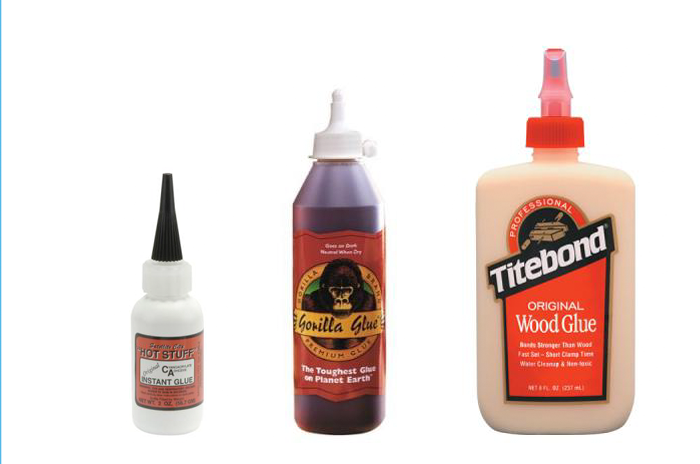Fretboard Glue


Guitar fretboards differ in size, design, and material. Generally all guitar fretboards are made out of some type of wood. The most common fretboards are made out of rosewood or ebony. Other fretboards are made out of maple. Even stranger, some guitars have graphite fretboards. All of these fretboards are glued to a neck and most fretboards have glued in frets and fretboard inlays. It is no wonder why beginner guitar builders and repairmen get confused about glue types when it comes to fretboards. There are so many different kinds. I will try to make it simple for you.
There are generally three different categories of glue for fretboards: wood glue, super glue, and expanding glue.
Wood glue, also commonly called yellow glue, is clear drying glue that is used to glue wood joints together. Wood glue is used most commonly on finished fretboards and some maple fretboards to glue frets into place. Wood glue is used because super glue can react with the fretboard finish. Sometimes resulting in bubbled finish and other times resulting in explosions. Mixing chemicals can be back. I like to use Titebond wood glue. I have used this glue for years and it has always given be strong, long lasting joints. You should have at least one bottle of Titebond wood glue in your guitar repair bench at all times. It's a lifesaver.
Super glue is used on unfinished fretboards for all kinds of repairs. Super glue can be used to fix and fill in cracks in your fretboard. It can also be used to glue in loose frets as well as loose inlay pieces. Super glue is a great glue to use because it forms a hard bond and dries quickly. Super will dry in seconds while wood glue could take a few hours to fully dry. Be careful with super glue. It is dangerous. Keep it away from your guitar's finish. Also, watch out for your fingers. Super glue can get on your finger while you are holding two pieces of wood to glue together. If you don't watch it, you might be the one being glue together. This can be very painful to try to unstick your fingers from something. Also, do not use super glue on a maple fretboard. Only use wood glue on maple fretboards. I like to use Satellite City super glue. This is professional grade super glue that dries in mere seconds after the accelerator is applied. I also keep a supple of Satellite City super glue in my guitar repair bench.
Expanding glue or Gorilla glue is a type of wood glue that expands and foams up while it dries. This is extremely helpful when you are gluing large flat, porous areas together. Gorilla glue works great for gluing the fretboard to the neck. The expanding glue creeps into the porous neck and holds it tight up against the fretboard. This is extremely strong holding glue with a relatively short set time. This glue is neat to watch dry. Put some on your fretboard, clamp it down, and wait for it to expand out of the seams. Gorilla glue is great. I also keep some handy in my guitar repair bench.
All three of these types of glue are used on all different parts of guitars—not just the fretboard. I recommend getting at least one bottle of each of these glues to keep in your shop. You be amazed at the different uses you find for them once you get them. If you would like more information about guitar glue, please see my guitar glue article.

